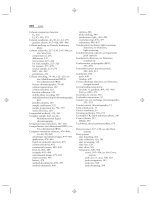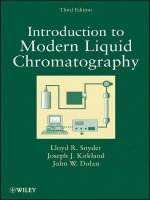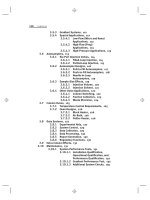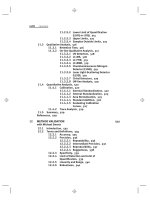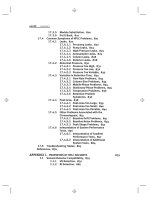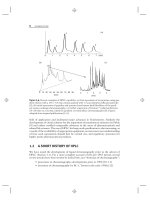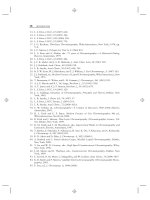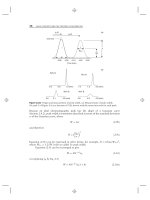Introduction to Modern Liquid Chromatography, Third Edition part 2 potx
Bạn đang xem bản rút gọn của tài liệu. Xem và tải ngay bản đầy đủ của tài liệu tại đây (59.6 KB, 10 trang )
viii CONTENTS
3.5.3 Gradient Systems, 112
3.5.4 Special Applications, 112
3.5.4.1 Low-Flow (Micro and Nano)
Applications, 112
3.5.4.2 High-Flow (Prep)
Applications, 113
3.5.4.3 High-Pressure Applications, 113
3.6 Autosamplers, 113
3.6.1 Six-Port Injection Valves, 114
3.6.1.1 Filled-Loop Injection, 114
3.6.1.2 Partial-Loop Injection, 115
3.6.2 Autosampler Designs, 116
3.6.2.1 Pull-to-Fill Autosamplers, 117
3.6.2.2 Push-to-Fill Autosamplers, 118
3.6.2.3 Needle-in-Loop
Autosamplers, 119
3.6.3 Sample-Size Effects, 119
3.6.3.1 Injection Volume, 120
3.6.3.2 Injection Solvent, 121
3.6.4 Other Valve Applications, 122
3.6.4.1 Column Switching, 122
3.6.4.2 Fraction Collectors, 123
3.6.4.3 Waste Diversion, 124
3.7 Column Ovens, 125
3.7.1 Temperature-Control Requirements, 125
3.7.2 Oven Designs, 126
3.7.2.1 Block Heater, 126
3.7.2.2 Air Bath, 126
3.7.2.3 Peltier Heater, 126
3.8 Data Systems, 127
3.8.1 Experimental Aids, 127
3.8.2 System Control, 129
3.8.3 Data Collection, 129
3.8.4 Data Processing, 130
3.8.5 Report Generation, 130
3.8.6 Regulatory Functions, 130
3.9 Extra-Column Effects, 131
3.10 Maintenance, 131
3.10.1 System-Performance Tests, 131
3.10.1.1 Installation Qualification,
Operational Qualification, and
Performance Qualification, 132
3.10.1.2 Gradient Performance Test, 132
3.10.1.3 Additional System Checks, 135
CONTENTS ix
3.10.2 Preventive Maintenance, 138
3.10.2.1 Periodic Maintenance, 138
3.10.2.2 Suggestions for Routine
Applications, 141
3.10.3 Repairs, 143
3.10.3.1 Personnel, 143
3.10.3.2 Record Keeping, 143
3.10.3.3 Specific Repair
Recommendations, 144
References, 144
4 DETECTION 147
4.1
Introduction, 148
4.2 Detector Characteristics, 149
4.2.1 General Layout, 149
4.2.2 Detection Techniques, 151
4.2.2.1 Bulk Property Detectors, 151
4.2.2.2 Sample-Specific Detectors, 152
4.2.2.3 Mobile-Phase Modification
Detectors, 152
4.2.2.4 Hyphenated Techniques, 152
4.2.3 Signal, Noise, Drift, and Assay
Precision, 152
4.2.3.1 Noise and Drift, 153
4.2.3.2 Signal-to-Noise Ratio (S/N), 155
4.2.4 Detection Limits, 157
4.2.5 Linearity, 158
4.3 Introduction to Individual Detectors, 160
4.4 UV-Visible Detectors, 160
4.4.1 Fixed-Wavelength Detectors, 163
4.4.2 Variable-Wavelength Detectors, 164
4.4.3 Diode-Array Detectors, 165
4.4.4 General UV-Detector Characteristics, 166
4.5 Fluorescence Detectors, 167
4.6 Electrochemical (Amperometric) Detectors, 170
4.7 Radioactivity Detectors, 172
4.8 Conductivity Detectors, 174
4.9 Chemiluminescent Nitrogen Detector, 174
4.10 Chiral Detectors, 175
4.11 Refractive Index Detectors, 177
4.12 Light-Scattering Detectors, 180
4.12.1 Evaporative Light-Scattering Detector
(ELSD), 181
x CONTENTS
4.12.2 Condensation Nucleation Light-Scattering
Detector (CNLSD), 182
4.12.3 Laser Light-Scattering Detectors (LLSD), 183
4.13 Corona-Discharge Detector (CAD), 184
4.14 Mass Spectral Detectors (MS), 185
4.14.1 Interfaces, 186
4.14.1.1 Electrospray Interface (ESI), 186
4.14.1.2 Atmospheric-Pressure
Chemical-Ionization Interface
(APCI), 187
4.14.1.3 Other Interface Designs, 188
4.14.1.4 Flow-Rate Considerations, 188
4.14.2 Quadrupoles and Ion Traps, 188
4.14.3 Other MS Detectors, 190
4.15 Other Hyphenated Detectors, 191
4.15.1 Infrared (FTIR), 191
4.15.2 Nuclear Magnetic Resonance (NMR), 192
4.16 Sample Derivatization and Reaction Detectors, 194
References, 196
5 THE COLUMN 199
5.1
Introduction, 200
5.2 Column Supports, 200
5.2.1 Particle Characterization, 201
5.2.1.1 Particle Type, 201
5.2.1.2 Particle Size and Pore
Diameter, 203
5.2.2 Silica Supports, 203
5.2.2.1 Column Efficiency, 205
5.2.2.2 Nature of the Silica Surface, 208
5.2.2.3 Particle Preparation, 211
5.2.3 Porous Polymers, 212
5.2.4 Monoliths, 212
5.2.4.1 Silica-Based Monoliths, 213
5.2.4.2 Polymer-Based Monoliths, 214
5.2.5 Other Inorganic Particles, 214
5.2.5.1 Zirconia, 215
5.2.5.2 Alumina and Titania, 217
5.2.5.3 Graphitized Carbon, 217
5.3 Stationary Phases, 217
5.3.1 ‘‘Bonded’’ Stationary Phases, 218
5.3.2 Other Organic-Based Stationary
Phases, 223
CONTENTS xi
5.3.2.1 Mechanically Held
Polymers, 223
5.3.2.2 Hybrid Particles, 223
5.3.2.3 Columns for Highly Aqueous
Mobile Phases, 224
5.3.3 Column Functionality (Ligand Type), 225
5.4 Column Selectivity, 227
5.4.1 Basis of RPC Column Selectivity, 227
5.4.1.1 Hyperbolic-Subtraction
Model, 229
5.4.1.2 Shape Selectivity, 232
5.4.2 Column Reproducibility and ‘‘Equivalent’’
Columns, 235
5.4.3 Orthogonal Separation, 236
5.4.4 Other Applications of Column
Selectivity, 237
5.4.4.1 Peak Tailing, 237
5.4.4.2 Stationary-Phase
De-Wetting, 237
5.4.4.3 Column Degradation, 238
5.5 Column Hardware, 238
5.5.1 Column Fittings, 238
5.5.2 Column Configurations, 239
5.6 Column-Packing Methods, 240
5.6.1 Dry-Packing, 240
5.6.2 Slurry-Packing of Rigid Particles, 240
5.6.2.1 Selection of Slurry Liquid, 241
5.6.2.2 Rigid Polymeric Particles, 243
5.6.3 Soft Gels, 244
5.7 Column Specifications, 244
5.7.1 Manufacturing Standards, 244
5.7.2 Column Plate Number, 245
5.8 Column Handling, 246
References, 250
6 REVERSED-PHASE CHROMATOGRAPHY FOR NEUTRAL SAM-
PLES 253
6.1
Introduction, 254
6.1.1 Abbreviated History of Reversed-Phase
Chromatography, 255
6.2 Retention, 256
6.2.1 Solvent Strength, 257
6.2.2 Reversed-Phase Retention Process, 259
6.3 Selectivity, 263
xii CONTENTS
6.3.1 Solvent-Strength Selectivity, 263
6.3.2 Solvent-Type Selectivity, 265
6.3.3 Temperature Selectivity, 270
6.3.3.1 Further Observations, 271
6.3.4 Column Selectivity, 273
6.3.5 Isomer Separations, 276
6.3.5.1 Enhanced Isomer Selectivity, 277
6.3.5.2 Shape Selectivity, 277
6.3.6 Other Selectivity Considerations, 278
6.3.6.1 Equivalent Separation, 279
6.3.6.2 Orthogonal Separation, 282
6.4 Method Development and Strategies for Optimizing
Selectivity, 284
6.4.1 Multiple-Variable Optimization, 286
6.4.1.1 Mixtures of Different Organic
Solvents, 287
6.4.1.2 Simultaneous Variation of
Solvent Strength and Type, 290
6.4.1.3 Simultaneous Variation of
Solvent Strength and
Temperature, 292
6.4.1.4 Change of the Column with
Variation of One or More Other
Conditions, 293
6.4.2 Optimizing Column Conditions, 295
6.5 Nonaqueous Reversed-Phase Chromatography
(NARP), 295
6.6 Special Problems, 297
6.6.1 Poor Retention of Very Polar Samples, 297
6.6.2 Peak Tailing, 298
References, 298
7 IONIC SAMPLES: REVERSED-PHASE, ION-PAIR, AND ION-
EXCHANGE CHROMATOGRAPHY 303
7.1
Introduction, 304
7.2 Acid–Base Equilibria and Reversed-Phase
Retention, 304
7.2.1 Choice of Buffers, 309
7.2.1.1 Buffer pK
a
and Capacity, 311
7.2.1.2 Other Buffer Properties, 314
7.2.1.3 Preferred Buffers, 316
7.2.2 pK
a
asaFunctionofCompound
Structure, 317
CONTENTS xiii
7.2.3 Effects of Organic Solvents and Temperature
on Mobile-Phase pH and Sample pK
a
Values, 317
7.2.3.1 Effect of %B on Values of
Effective pK
a
for the Solute, 318
7.2.3.2 Effect of Temperature on Values
of pK
a
,319
7.3 Separation of Ionic Samples by Reversed-Phase
Chromatography (RPC), 319
7.3.1 Controlling Retention, 320
7.3.2 Controlling Selectivity, 320
7.3.2.1 Mobile-Phase pH, 320
7.3.2.2 Solvent Strength (%B) and
Temperature, 322
7.3.2.3 Solvent Type, 323
7.3.2.4 Column Type, 323
7.3.2.5 Other Conditions That Can Affect
Selectivity, 326
7.3.3 Method Development, 327
7.3.3.1 Starting Conditions, 327
7.3.3.2 Optimizing Selectivity, 328
7.3.4 Special Problems, 329
7.3.4.1 pH Sensitivity, 329
7.3.4.2 Silanol Effects, 330
7.3.4.3 Poor Retention of the
Sample, 331
7.3.4.4 Temperature Sensitivity, 331
7.4 Ion-Pair Chromatography (IPC), 331
7.4.1 Basis of Retention, 334
7.4.1.1 pH and Ion Pairing, 334
7.4.1.2 Ion-Pair Reagent: Concentration
and Type, 336
7.4.1.3 Simultaneous Changes in pH and
Ion Pairing, 337
7.4.2 Method Development, 339
7.4.2.1 Choice of Initial Conditions, 340
7.4.2.2 Control of Selectivity, 343
7.4.2.3 Summary, 346
7.4.3 Special Problems, 347
7.4.3.1 Artifact Peaks, 347
7.4.3.2 Slow Column Equilibration, 347
7.4.3.3 Poor Peak Shape, 349
7.5 Ion-Exchange Chromatography (IEC), 349
xiv CONTENTS
7.5.1 Basis of Retention, 351
7.5.2 Role of the Counter-Ion, 352
7.5.3 Mobile-Phase pH, 354
7.5.4 IEC Columns, 354
7.5.5 Role of Other Conditions, 354
7.5.6 Method Development, 355
7.5.7 Separations of Carbohydrates, 355
7.5.8 Mixed-Mode Separations, 355
References, 357
8 NORMAL-PHASE CHROMATOGRAPHY 361
8.1
Introduction, 362
8.2 Retention, 363
8.2.1 Theory, 366
8.2.2 Solvent Strength as a Function of the
B-Solvent and %B, 370
8.2.3 Use of TLC Data for Predicting NPC
Retention, 373
8.3 Selectivity, 376
8.3.1 Solvent-Strength Selectivity, 376
8.3.2 Solvent-Type Selectivity, 376
8.3.3 Temperature Selectivity, 380
8.3.4 Column Selectivity, 381
8.3.5 Isomer Separations, 382
8.4 Method-Development Summary, 385
8.4.1 Starting Conditions for NPC Method
Development: Choice of Mobile-Phase
Strength and Column Type, 388
8.4.2 Strategies for Optimizing Selectivity, 389
8.4.3 Example of NPC Method Development, 390
8.5 Problems in the Use of NPC, 392
8.5.1 Poor Separation Reproducibility, 392
8.5.2 Solvent Demixing and Slow Column
Equilibration, 394
8.5.3 Tailing Peaks, 394
8.6 Hydrophilic Interaction Chromatography (HILIC), 395
8.6.1 Retention Mechanism, 396
8.6.2 Columns, 397
8.6.3 HILIC Method Development, 398
8.6.4 HILIC Problems, 401
References, 401
9 GRADIENT ELUTION 403
9.1
Introduction, 404
CONTENTS xv
9.1.1 Other Reasons for the Use of Gradient
Elution, 406
9.1.2 Gradient Shape, 407
9.1.3 Similarity of Isocratic and Gradient
Elution, 409
9.1.3.1 The Linear-Solvent-Strength
(LSS) Model, 409
9.1.3.2 BandMigrationinGradient
Elution, 411
9.2 Experimental Conditions and Their Effects on
Separation, 412
9.2.1 Effects of a Change in Column
Conditions, 415
9.2.2 Effects of Changes in the Gradient, 418
9.2.2.1 Initial-%B, 419
9.2.2.2 Final-%B, 420
9.2.2.3 Gradient Delay, 422
9.2.2.4 Dwell-Volume, 424
9.2.2.5 Segmented Gradients, 425
9.2.3 ‘‘Irregular Samples’’, 428
9.2.4 Quantitative Relationships, 430
9.2.4.1 Retention Time, 431
9.2.4.2 Measurement of Values of S and
k
w
,432
9.2.4.3 Peak Width, 433
9.2.4.4 Resolution, 434
9.3 Method Development, 434
9.3.1 Initial Gradient Separation, 437
9.3.1.1 Choosing between Isocratic and
Gradient Elution, 437
9.3.1.2 Possible Problems, 440
9.3.2 Optimize k
∗
, 442
9.3.3 Optimize Gradient Selectivity α
∗
, 442
9.3.4 Optimizing Gradient Range, 444
9.3.5 Segmented (Nonlinear) Gradients, 445
9.3.6 Optimizing the Column Plate Number
N
∗
, 445
9.3.7 Determine Necessary Column-Equilibration
Time, 446
9.3.8 Method Reproducibility, 449
9.3.8.1 Method Development, 449
9.3.8.2 Routine Analysis, 450
9.3.9 Peak Capacity and Fast Separation, 451
9.3.9.1 Optimized Peak Capacities, 453
xvi CONTENTS
9.3.9.2 Fast Gradient Separations, 456
9.3.10 Comprehensive Two-Dimensional HPLC, 457
9.3.10.1 Principles of LC × LC, 458
9.3.10.2 Peak Capacity, 461
9.3.10.3 Instrumentation for LC × LC, 461
9.3.10.4 Method Development for
LC × LC, 462
9.4 Large-Molecule Separations, 464
9.5 Other Separation Modes, 465
9.5.1 Theory, 465
9.5.2 Normal-Phase Chromatography (NPC), 466
9.5.3 Hydrophilic-Interaction Chromatography
(HILIC), 467
9.5.3.1 Applications, 467
9.5.3.2 Separation Conditions, 468
9.5.4 Ion-Exchange Chromatography (IEC), 470
9.6 Problems, 470
9.6.1 Solvent Demixing, 470
9.6.2 Ghost Peaks, 470
9.6.3 Baseline Drift, 470
References, 471
10 COMPUTER-ASSISTED METHOD DEVELOPMENT 475
10.1
Introduction, 475
10.1.1 Basis and History of Computer
Simulation, 478
10.1.2 When to Use Computer Simulation, 478
10.1.2.1 Advantages, 479
10.1.2.2 Disadvantages, 480
10.2 Computer-Simulation Software, 481
10.2.1 DryLab Operation, 481
10.2.2 Gradient Optimization, 483
10.2.3 Other Features, 485
10.2.3.1 Isocratic Predictions from
Gradient Data, 485
10.2.3.2 Designated-Peak Selection, 486
10.2.3.3 Change in Other Conditions, 487
10.2.3.4 Computer Selection of the Best
Multi-Segment Gradient, 488
10.2.3.5 Peak Tailing, 488
10.2.3.6 Two-Run Procedures for the
Improvement of Sample
Resolution, 488
CONTENTS xvii
10.2.3.7 Examples of Computer
Simulation as Part of Method
Development, 489
10.2.4 Peak Tracking, 489
10.2.5 Sources of Computer-Simulation
Software, 489
10.3 Other Method-Development Software, 491
10.3.1 Solute Retention and Molecular
Structure, 491
10.3.2 Solute pK
a
Values and Molecular
Structure, 491
10.3.3 Reversed-Phase Column Selectivity, 492
10.3.4 Expert Systems for Method
Development, 492
10.4 Computer Simulation and Method Development, 492
10.4.1 Example 1: Separation of a Pharmaceutical
Mixture, 492
10.4.2 Example 2: Alternative Method Development
Strategy, 494
10.4.3 Verifying Method Robustness, 496
10.4.4 Summary, 497
References, 497
11 QUALITATIVE AND QUANTITATIVE ANALYSIS 499
11.1
Introduction, 499
11.2 Signal Measurement, 500
11.2.1 Integrator Operation, 500
11.2.1.1 Data Sampling, 501
11.2.1.2 Peak Recognition, 503
11.2.1.3 Integration of Non-Ideal
Chromatograms, 504
11.2.1.4 Common Integration Errors, 505
11.2.1.5 Additional Suggestions, 506
11.2.2 Retention, 507
11.2.3 Peak Size, 508
11.2.4 Sources of Error, 508
11.2.4.1 Sampling and Cleanup, 509
11.2.4.2 Chromatography, 509
11.2.4.3 Detection, 509
11.2.4.4 Peak Measurement, 510
11.2.4.5 Calibration, 510
11.2.5 Limits, 512
11.2.5.1 Limit of Detection (LOD), 513
